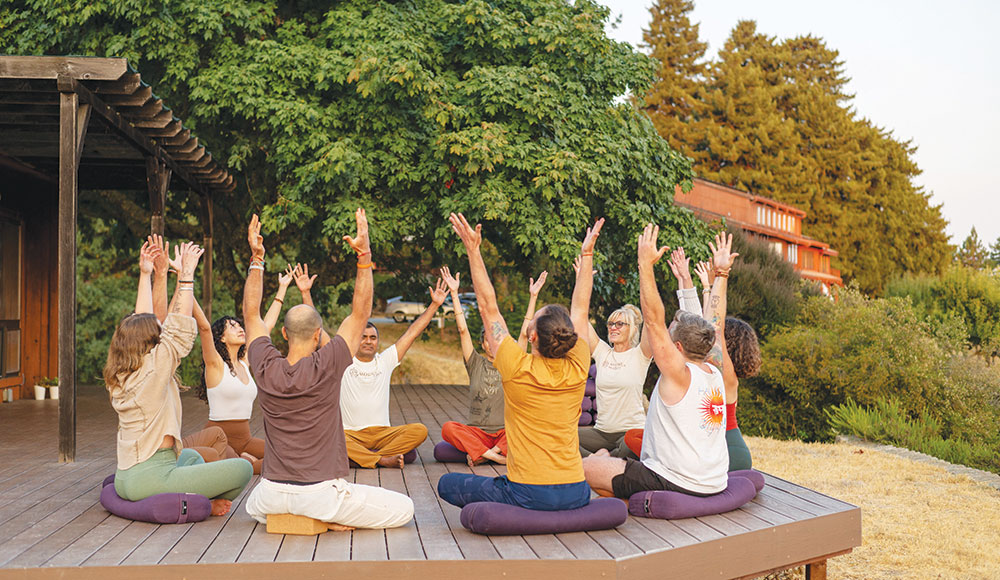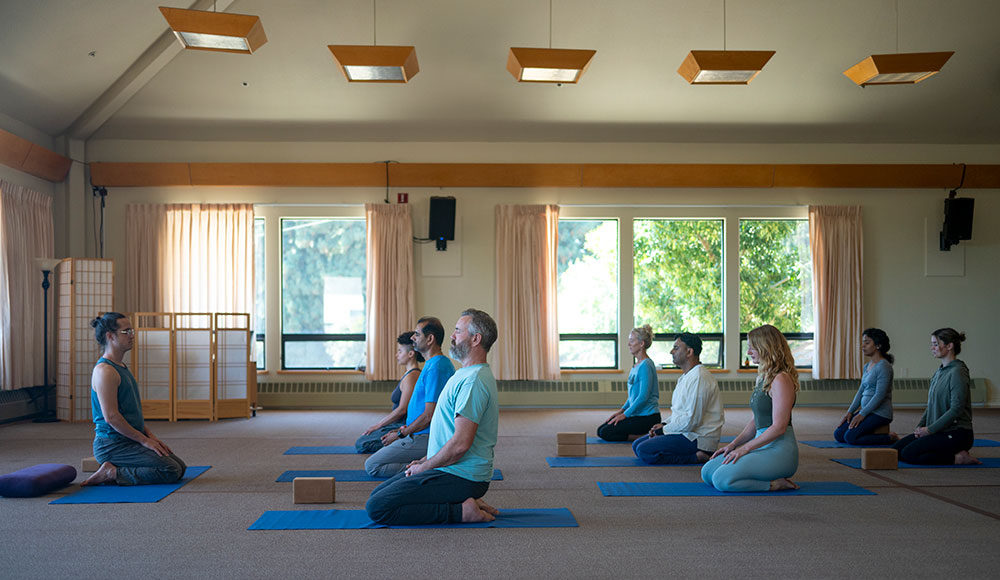A cool breeze cut through the chatter on the rooftop patio, where the weight of all the tech talk at a recent networking event was nearly tangible. Feeling slightly out of place, I struck up a conversation with a man in reflective wraparound sunglasses. As we talked, we realized we’d met before—during an interview at a local yoga studio, where he’d joined the conversation as the CEO.
This evening, I also learned he co-founded CrossFit, the privately held global fitness brand now estimated to generate over $100 million annually. Clearly Hot Elevation is in good hands. I ask him whether the popular yoga studio, which is slated for relocation in the fall of this year, is worried about competition. “No,” he confidently replies. “We know we just have to keep innovating.”
The comment stayed with me as I stepped into the elevator down to Pacific Avenue and all through the drive home. It somehow felt counterintuitive based on my traditional yoga teaching, which was more about cultivating inner self-awareness than even the postures we learned. But I get it: If consumers demand innovation, businesses need to respond to survive.
Still, I continued to wonder, does yoga really have to keep innovating to stay relevant? No doubt this practice will help you to strengthen, lengthen and balance your physical form. And a one-hour heated power vinyasa class is a great way to burn all kinds of calories. But is that really the true intention of yoga?
The Yoga Lifestyle
As yoga teacher Alisha Slaughter told a recent class of practitioners at Capitola’s Breath+Oneness, “With all the unrest in the world, I feel like yoga is an act of rebellion. By regulating our nervous system, refusing to get caught up in the confusion, we’re standing up to the man.”
Long before yoga was a billion-dollar industry with fancy gear and branded water bottles, it started as a quiet revolution—one that found fertile ground here on the edge of the Pacific. Santa Cruz may be known for its surf, redwoods and laid-back vibe, but it also holds a significant, if often unsung, place in the history of yoga in the West.
The roots of yoga in Santa Cruz stretch back to the 1960s and ’70s, when seekers began looking beyond conventional religion for spiritual guidance. At that time, Mount Madonna Center—now a world-renowned yoga and retreat destination—was just beginning to take shape.
Founded in 1978 by students of Baba Hari Dass, a silent monk from North India who taught classical Ashtanga Yoga and philosophy, Mount Madonna brought a deep authenticity to the region’s yoga culture. It wasn’t about perfecting your handstand or earning a teaching certificate; it was about transformation through disciplined practice, service and self-inquiry. That foundation continues to inspire generations of yogis today.
The practice arrived at UCSC in a series of classes led by Ann Barros in the late 1970s. Meanwhile, the Santa Cruz community was also home to other spiritual leaders and influences. From the Vedanta Society’s teachings on Pacific Avenue to community centers offering everything from breathwork to Kundalini, yoga became part of the city’s countercultural DNA. It was never just fitness. It was a lifestyle, a worldview, a spiritual practice.
TriYoga was one of the first yoga centers to appear in Santa Cruz. This flowing, meditative style of yoga described as systematic practice designed to awaken the body’s natural rhythms and inner wisdom was founded by internationally renowned teacher Kali Ray. The studio remained a viable part of the community from 1986 to 2019, and although no longer part of the Santa Cruz scene, the teaching continues on a global level today.
Eventually the Pacific Cultural Center, formerly located on Seabright Avenue, expanded the Ashtanga tradition from Mount Madonna to Midtown. It was also the studio where I first discovered yoga, becoming part of a community committed to practicing with renowned teacher Kelly Blaser.
In 1988 Yoga Center Santa Cruz was founded by Ruth Hille, Juliet Heizman and Susan Merritt as an Iyengar-based studio, a practice known for its use of props such as belts and blocks. Iyengar is a form of another style, Hatha yoga, which focuses on the structural alignment of the physical body through the development of asanas, or postures. Renowned teacher Kofi Busia later joined and continues to teach there today.
By the ’90s and early 2000s, the yoga scene had begun to expand. Village Yoga, the first local heated studio, arrived on the scene in 2001. Co-founder Amy Mihal explains she and Sally Adams “were young and just so passionate about sharing our love for the yoga” after completing their Bikram training in 1999. They were based in San Francisco and didn’t know much about Santa Cruz, other than there weren’t any hot yoga studios there. Looking back, Mihal says, she can’t believe they “had the gumption” to start Village Yoga.
It was around this time that yoga started to find its way into mainstream wellness culture. Surfers, college students, tech workers and new moms all started discovering the benefits of a regular practice. Yoga became less of a fringe pursuit and more of a community touchstone. By 2009 there were more than 20 yoga venues in Santa Cruz, each with a varying technique and purpose.
What made our hometown yoga scene unique wasn’t just its accessibility—it was its authenticity. This wasn’t LA or NYC, where yoga often came wrapped in hype and hashtags. In Santa Cruz, yoga was still grounded in service, spirit and community.

Pandemic Pause and Quiet Return
When COVID-19 hit, yoga, like everything else, went quiet. Studios shuttered, classes moved online, and shared practice turned into solo sessions in front of laptop screens. Some longtime studios closed for good, while others decided it was time to get creative.
Teachers began offering donation-based classes in parks, on beaches and under redwoods. Online platforms blossomed, and many local instructors built followings far beyond city limits. In some ways, the pandemic reminded us of yoga’s most important teaching: how to return to ourselves when the world turns upside down.
Today, yoga in Santa Cruz is thriving once again—but with a renewed sense of purpose. It’s less about chasing the perfect pose and more about cultivating resilience, healing and connection. Most studios managed to reopen; some, like Yoga Center Santa Cruz, were forced to relocate. Last November they reopened in the former Hart’s Fabric space.
I spoke with Maya Lev, Yoga Center Santa Cruz’s studio owner since 1993. She says that in the months since their move, all of the teachers are experiencing a resurgence. It’s typical to have 25 to 28 students attend a Sunday morning class, most of whom Lev describes as “in the upper years,” including many former yogis, but more younger people as well. “After 30 plus years of teaching, I’m happy to say traditional yoga is alive and well. Like any good product, fads will come and go but thanks to word of mouth and loyal customers, quality always sustains.”
Village Yoga’s Amy Mihal says in terms of student trends, she sees so many types of people from all walks of life; a wide range of ages, a lot more men and younger people coming in. She attributes this to benefits which go beyond the physical. “For many people yoga also addresses a sense of mental well-being, emotional balance and just helping people feel grounded, stable, strong and steady not just in the physical plane but really in all of the parts of our humanness.”
A Living Legacy
Whether you first experienced yoga through a class at Cabrillo, a retreat at Mount Madonna, or a session at your local gym, chances are it left an impression. Because yoga is more than just a workout—it’s an invitation to turn inward. It’s a spiritual practice that’s not about religion; instead, it’s about tuning into your deepest sense of self. It’s how we remember to slow down and breathe in a world that too often urges us to speed up and scroll on.
“The heart of the personal and spiritual growth that is yoga’s true potential lies less in the specific movement sequences and more in how you pay attention as you move and how you apply the resulting insights to your daily life,” Dr. Amanda Blake writes in Your Body is Your Brain. “When you learn to pay attention in this way you can do so just as easily walking down the street as you can in the studio.”
As we continue to navigate uncertainty—climate change, social unrest, personal upheaval—yoga remains a powerful tool for grounding, growth and grace. And in Santa Cruz, it’s not going anywhere.
So unroll your mat. Inhale the salt air. Exhale the noise. And whatever your practice looks like, know you’re part of a movement rooted in wisdom, community and the simple act of coming home to yourself.













Thank you for this very nice article, there is so much history in Santa Cruz, we are blessed to have been the center of so much spiritual and physical transformation and grounding. I was blessed to study with Baba Hari Dass for 3 decades and teach at PCC for much of that time.
Pacific Cultural Center offered weekly Adaptive Yoga classes for individuals with special needs, a program that was one of the first in the country to recognize the need for folks less fortunate to avail themselves to the wonderful gifts that Yoga had to offer. Teachers from here and around the country came learn how to facilitate and to volunteer in our program. We had an outreach program in the local schools for children as well, funded by local non profits. The Sentinel newspaper which was heralding local events ran a front page story about this class. Just thought you might want to know about it for any future research. Namasté
Our website is no longer in use unfortunately.